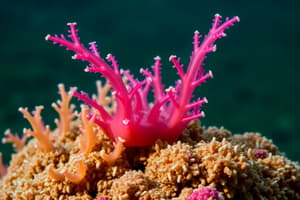Podcast
Questions and Answers
What is the primary function of scales in fish?
What is the primary function of scales in fish?
- Protection and thermoregulation (correct)
- Enhancing vision capabilities
- Assisting in reproduction
- Aiding in communication
How do fish regulate their body temperature?
How do fish regulate their body temperature?
- By their eyesight
- Via their scales
- Using their gills (correct)
- Through their fins
Which behavior provides insights into social structure, communication, and reproduction of fish?
Which behavior provides insights into social structure, communication, and reproduction of fish?
- Foraging behavior
- Schooling behavior (correct)
- Escape behavior
- Reproductive behavior
What is an important aspect of fisheries management related to setting fishing quotas?
What is an important aspect of fisheries management related to setting fishing quotas?
How do fish communicate with each other?
How do fish communicate with each other?
What is the main purpose of collaborative management in fisheries?
What is the main purpose of collaborative management in fisheries?
What is the main goal of aquaculture?
What is the main goal of aquaculture?
What role does aquaculture play in meeting the demand for fish and seafood?
What role does aquaculture play in meeting the demand for fish and seafood?
How does the body shape of fish help them in their aquatic environment?
How does the body shape of fish help them in their aquatic environment?
What is the significance of understanding fish anatomy?
What is the significance of understanding fish anatomy?
How do aquaculture farmers control the environmental impact of their operations?
How do aquaculture farmers control the environmental impact of their operations?
Which of the following is NOT commonly cultivated in aquaculture?
Which of the following is NOT commonly cultivated in aquaculture?
Study Notes
Zoology: Exploring the Aquatic Realm
Zoology, the study of animals, encompasses a wide range of organisms, including those that thrive in aquatic environments. In this article, we'll delve deeper into the subfields of zoology that revolve around aquatic life, particularly focusing on aquaculture, fish anatomy, fish behavior, and fisheries management.
Aquaculture
Aquaculture is the controlled cultivation of aquatic organisms, such as fish, mollusks, crustaceans, and aquatic plants. This fast-growing industry aims to provide a sustainable source of protein and generate economic benefits for people worldwide. Aquaculture is practiced on a grand scale in various parts of the world, from small-scale pond systems to large marine operations.
Aquaculture plays a crucial role in meeting the increasing demand for fish and seafood due to its ability to produce high-quality products efficiently and sustainably. By controlling the growth conditions, aquaculture farmers can minimize the environmental impact and ensure a steady supply of fish for human consumption.
Fish Anatomy
Fish are a diverse group of vertebrates that inhabit various aquatic habitats. A thorough understanding of their anatomical structures helps us appreciate their evolutionary adaptations and the physiological challenges they face.
The main features of fish anatomy include:
- Body shape: Streamlined bodies help fish reduce drag and increase efficiency while swimming.
- Scales: Primarily for protection and thermoregulation, scales can also help reduce drag.
- Skeleton: Most fish have a relatively light, hydrostatic skeleton composed of cartilage, which allows them to maintain buoyancy.
- Fins: Fins help fish maintain balance and propulsion.
- Gills: Responsible for extracting oxygen from water, gills also help fish regulate their body temperature.
- Eyes: Eyes are positioned on the sides of the head, allowing fish a wide field of vision, aiding in predation and avoiding predators.
Fish Behavior
To fully understand fish, it's essential to examine their behavior. Studying fish behavior gives us insights into their social structure, communication, and reproduction, all of which are critical factors in fish conservation and management.
Key aspects of fish behavior include:
- Social behavior: Fish live in various social structures, from solitary to schooling behavior.
- Communication: Fish use chemical, visual, and acoustic cues to communicate with others.
- Reproduction: Spawning behaviors vary among fish species, with some fish guarding their eggs and others leaving them to fend for themselves.
- Foraging: Fish exhibit various feeding strategies, such as filter feeders, predators, and scavengers.
- Escape behavior: Fish employ a variety of escape tactics, including quick bursts of speed or camouflage to evade predators.
Fisheries Management
Fisheries management involves the conservation, protection, and utilization of fish and other aquatic resources. By implementing sustainable practices, fisheries managers help ensure a stable and consistent supply of fish while maintaining the health of aquatic ecosystems.
Effective fisheries management considers factors such as:
- Stock assessment: The process of determining the size of fish populations, their age structure, and reproductive potential.
- Harvest strategies: Setting fishing quotas and season dates to allow fish populations to recover and reproduce.
- Bycatch reduction: Minimizing the accidental capture of non-target species.
- Habitat conservation: Protecting and restoring essential habitats for fish to thrive.
- Collaborative management: Working with various stakeholders, including fishermen, scientists, and government agencies, to ensure the long-term sustainability of fisheries.
In summary, zoology's focus on aquatic life provides valuable insights into the biology, behavior, and management of aquatic organisms. By understanding aquaculture, fish anatomy, fish behavior, and fisheries management, we can better appreciate the complexities of aquatic ecosystems and safeguard their future.
Studying That Suits You
Use AI to generate personalized quizzes and flashcards to suit your learning preferences.
Description
Discover the fascinating world of aquatic zoology with a focus on aquaculture, fish anatomy, behavior, and fisheries management. Learn about sustainable aquaculture practices, the anatomical structures of fish, key aspects of fish behavior, and effective fisheries management strategies.




